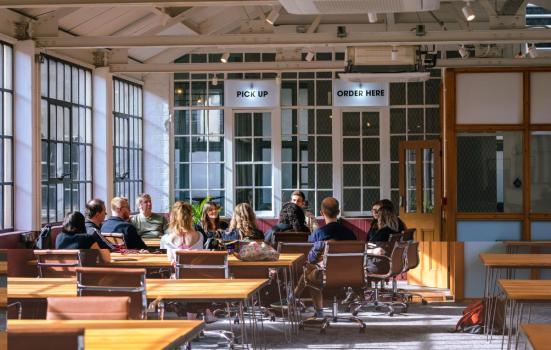Recruiting for digital roles is tricky, which is understandable given cultural organisations have not traditionally had to hire for these skills. Ash Mann shares his experience of rethinking the structure and roles of digital teams.

Given the increasingly pressing need for in-house digital expertise, recruiters need to know (and properly advertise for) the specific skills they require, and know how and where to look for them. People are your most important asset and the impact of getting a hire wrong can be significant - research shows a bad hire can cost tens of thousands of pounds.
Based on our experience at Substrakt, we think organisations can improve the effectiveness of their recruitment by thinking differently about how they talk about themselves as employers, being clear about the skills they really need, and adopting an ‘always hiring’ mindset.
Not reaching people in the right ways
In a previous article about digital skills we addressed sustainable and focused skills development, but cultural organisations struggle with recruiting digital-focused roles in the first place.
This may be due to remuneration in the sector - but the same is true of many specialist sector roles. We know cultural organisations can offer varied, mission-driven, audience-focused opportunities that digital professionals are hungry for. Ones that don’t exist in other sectors.
As a sector, we’re not very good at showcasing our organisations as places of work. But there are some inspiring examples, such as international design agency DNCO, which showcases its mission, values, culture and history before talking about current vacancies. So potential applicants get a strong sense of who they are, what it might be like to work there and the type of people they are looking for.
A new approach
We also need to ensure job opportunities that do exist in the sector are reaching the right people. This is often a problem for roles outside the ‘main thing’ (performance, exhibitions etc), which are less visible. It’s no surprise that many young people don’t know what careers are possible in the sector if their skills and interests fall outside the obviously relevant ones relating to performance or production.
Cultural organisations often advertise all roles the same way. Unsurprisingly, this means they struggle to fill the specialist ones, particularly those you don’t expect to find in a cultural organisation. To ‘fish where the fish are’, organisations should try to identify specialist job boards and advertise where most job seekers are looking.
Instead we see companies either all advertising in the same place, or only on their own websites and social platforms. We have experienced this problem at Substrakt but a few conversations with the Tech Talent Charter’s COO, Lexie Papaspyrou, changed our approach entirely.
Your employer brand
We were struggling to attract the people we wanted, and a comprehensive review of our positioning showed that weren’t showcasing Substrakt as a workplace. There were few team images, no sense of what an average day would look like, and little clarity about benefits or company culture.
Equally, we didn’t communicate compellingly enough about the kinds of companies we worked with. This is a mistake almost every cultural organisation makes. They focus almost entirely on the primary target audience - ticket-buyers, exhibition-attenders, workshop-bookers – overlooking the need to create a sense of their workplace.
Outside the sector there are many examples of organisations doing this well. The communications platform Slack and toy company Lego both host careers pages that communicate their mission, values, benefits (beyond remuneration) and workplace culture clearly, before listing vacancies. They both extend their brand to this part of the site, using graphic, photographic and video content thoughtfully to strengthen their ‘story’.
Lots of the ‘good’ examples are so because of the content, which should be something cultural organisations can readily draw from - from ensuring the right tone of voice, and that FAQs are answered, to sharing images of the workspaces, and videos of the team talking about working life.
The best examples know and communicate the kind of people they want beyond the specifics of the vacancies, and then are clear about the recruitment process - both important factors that make your company more attractive while simultaneously increasing the likelihood of the right people applying.
What do you really need?
Data analysis, content design, product management, video editing, user research, graphic design, web development, technical knowledge, SEO - some of the many things that digital activity encompasses and all distinct specialisms with little or no overlap, yet often crammed together in job descriptions for digital roles.
But what is the most impactful fit for your needs? Resource constraints mean most organisations need folk who can work strategically and oversee varied and complex workstreams, rather than a hyper-specialist. Job descriptions need to reflect this.
The generalists actually needed to manage and lead digital activity may have experience in a few areas but are unlikely to have in-depth knowledge in more than one or two. There will, however, be external freelancers, agencies and others who can provide specialist services as required.
People with a digital responsibilities do a lot of advocacy and change-making as they are often surrounded by non-digital mindsets, processes, structures and culture. As Louise Cohen (formerly Head of Digital Content & Channels, Royal Academy of Arts) said in our Digital Works Podcast: “After launching the content strategy, we did a bit of a roadshow and everyone was really excited and we were like, cool, we've got buy-in... And then a year later, two years later, 50% of the staff are different and you think, okay, we have to keep doing this.”
When there is a compelling need for a specialist role, make sure you use language that mirrors how those responsibilities are referred to in the wider job market, rather than using overly arts- or internally-focused language.
Always be hiring
Many organisations only think about recruitment when they need to recruit. But this stop/start, ad hoc approach is probably undermining your efforts. If instead you are consistently active, always welcoming applicants even without a specific vacancy, you will be in a far better position when a need arises. Building a longer-term talent pipeline will mean you can focus on reaching people who don’t traditionally apply, from marginalised and underrepresented groups.
This may not be feasible, given your organisation’s resources, so working with recruiters can help. The cost may be such that organisations automatically discount the option, but that’s a false economy. Factoring in the cost of getting a hire wrong and the time a recruitment process takes, using a recruiter becomes a sensible investment.
A good one will understand the market and the type of candidates you want to reach and should already people in mind when you brief them. We mostly work with specialist digital recruiters - that’s how we got the best results.
In summary
The culture sector faces an ongoing challenge with recruitment and retention, which needs addressing for its long term health and success. Unless you work for a large organisation, recruitment is most likely an additional responsibility for someone who is already working flat out.
While the approach outlined here is more work in the short term, we think it saves time and effort, as well as significantly increasing your chances of successful hire. Of course, the experience of any applicant to your organisation is as important everything above. And being proactive, friendly, transparent, inclusive and fair in your dealing with them is absolutely key.
Ash Mann is Managing Director at Substrakt and Strategy Director at Creating Impakt.
![]() substrakt.com | ashmann.medium.com
substrakt.com | ashmann.medium.com
![]() @substrakt | @biglittlethings
@substrakt | @biglittlethings
This article is part of a series contributed by Substrakt exploring the many ways in which arts and cultural organisations can embrace the world of digital.






Comments
olivervh replied on Permalink
The gradual evolution of digital roles in the cultural sector
ashleymann replied on Permalink
(No subject)